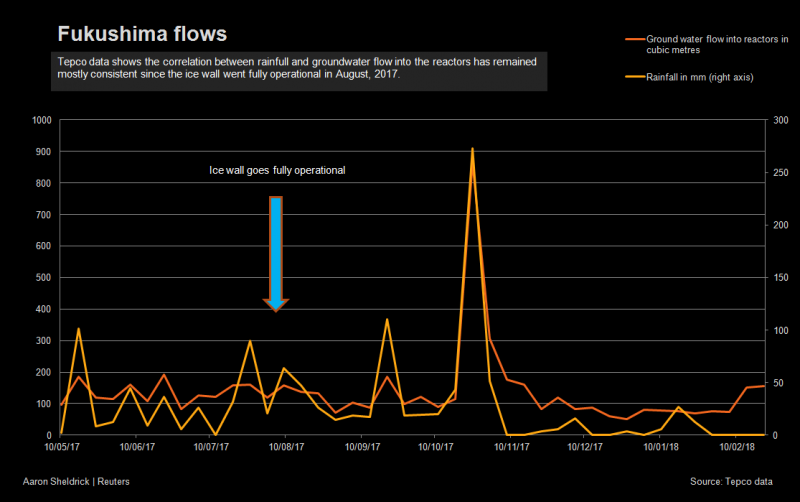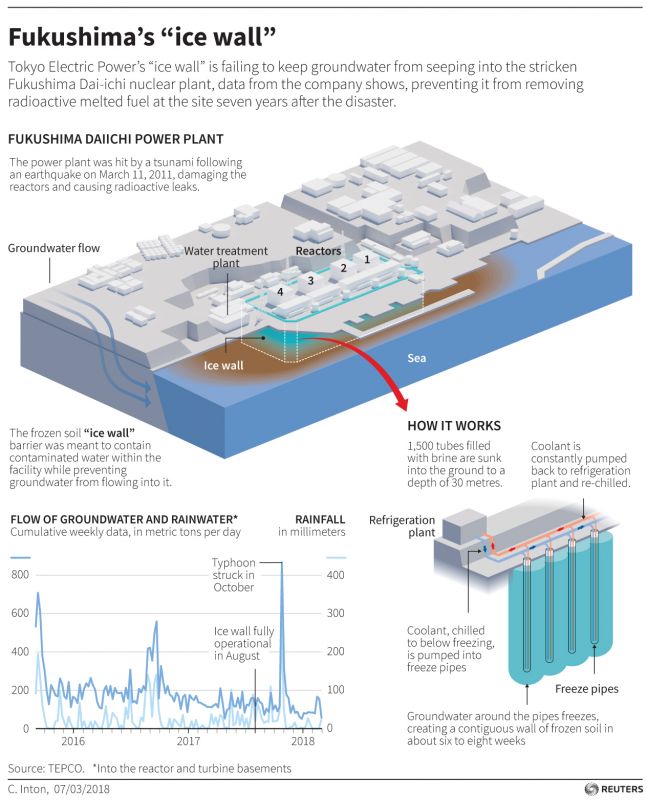Tepco's 'Ice Wall' Fails to Freeze Fukushima's Toxic Water Buildup
Published on by Water Network Research, Official research team of The Water Network in Technology
A costly “ice wall” is failing to keep groundwater from seeping into the stricken Fukushima Dai-ichi nuclear plant, data from operator Tokyo Electric Power Co shows, preventing it from removing radioactive melted fuel at the site seven years after the disaster.
When the ice wall was announced in 2013, Tepco assured sceptics that it would limit the flow of groundwater into the plant’s basements, where it mixes with highly radioactive debris from the site’s reactors, to “nearly nothing.”
However, since the ice wall became fully operational at the end of August, an average of 141 metric tonnes a day of water has seeped into the reactor and turbine areas, more than the average of 132 metric tonnes a day during the prior nine months, a Reuters analysis of the Tepco data showed.
The groundwater seepage has delayed Tepco’s clean-up at the site and may undermine the entire decommissioning process for the plant, which was battered by a tsunami seven years ago this Sunday. Waves knocked out power and triggered meltdowns at three of the site’s six reactors that spewed radiation, forcing 160,000 residents to flee, many of whom have not returned to this once-fertile coast.
Though called an ice wall, Tepco has attempted to create something more like a frozen soil barrier.
Using 34.5 billion yen ($324 million) in public funds, Tepco sunk about 1,500 tubes filled with brine to a depth of 30 meters (100 feet) in a 1.5-kilometre (1-mile) perimeter around four of the plant’s reactors. It then cools the brine to minus 30 degrees Celsius (minus 22 Fahrenheit).
The aim is to freeze the soil into a solid mass that blocks groundwater flowing from the hills west of the plant to the coast.
However, the continuing seepage has created vast amounts of toxic water that Tepco must pump out, decontaminate and store in tanks at Fukushima that now number 1,000, holding 1 million tonnes. It says it will run out of space by early 2021.

TYPHOON
The water inflows often fluctuate with rainfall. The dry month of January averaged 83 tons a day, Tepco data showed.
But when a typhoon struck during the last week of October, 866 tons a day poured into the reactors.
Overall, Tepco says a combination of drains, pumps and the ice wall has cut water flows by three-quarters, from 490 tons a day during the December 2015 to February 2016 period to an average of 110 tons a day for December 2017 to February 2018.
It is hard to measure exactly how much the ice wall is contributing, Tepco officials say, but based on computer analysis the utility estimates the barrier is reducing water flows by about 95 tonnes a day compared to two years ago, before the barrier was operating.
In addition to the building costs, the ice wall needs an estimated 44 million kilowatt hours of electricity a year to run, enough to power about 15,000 typical Japanese homes.

Reporting by Malcolm Foster and Aaron Sheldrick; Editing by Christian Schmollinger
Source: Reuters
Media
Taxonomy
- Toxins
- Groundwater
- Groundwater Pollution